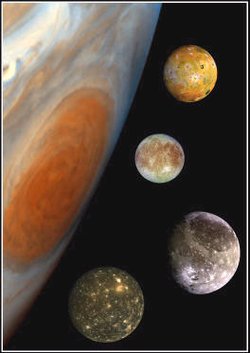Galilean moons
|
|
The Galilean moons are the four moons of Jupiter discovered by Galileo Galilei. By far the largest of the many moons of Jupiter, they are visible even in a low-power telescope. In fact, if the observing conditions are perfect, it is just possible to see Callisto, the outermost, with the unaided eye. They were first observed by Galileo on January 7, 1610.
Galileo observed the moons' motion over several days and realized that they were in orbit around Jupiter. This discovery supported the heliocentric theory of Nicolaus Copernicus and showed that not everything revolves around the Earth.
Galileo first called his discovery the Cosmica Sidera, in honour of Cosimo II dé Medici (1590–1621), grand-duke of Tuscany from 1609, whose patronage Galileo wanted to secure. At the grand-duke's suggestion, Galileo changed the name to Medicea Sidera ("Médici stars"), because the Médici were four brothers. The discovery was announced in the Sidereus Nuncius ("Starry Messenger"), published in Venice in March 1610, less than two months after the first observations.
Amongst the other names that were put forward, there is Principharus, Victipharus, Cosmipharus and Ferdinandipharus, for each of the four Médici brothers, proposed by Giovanni Battista Hodierna, a disciple of Galileo and author of the first ephemerides (Medicaeorum Ephemerides, 1656). Johannes Hevelius called them the Circulatores Jovis or Jovis Comites, and Jacques Ozanam called them Gardes or Satellites (from the Latin satelles, satellitis: escort). It would be the names proposed by Simon Marius (Simon Mayer), who pretended to have discovered the moons at the same time as Galileo, that would eventually prevail: Io, Europa, Ganymede and Callisto, published in his Mundus Jovialis in 1614. Galileo steadfastly refused to use Marius' names and invented as a result the numbering scheme that is still used nowadays, in parallel with proper moon names. The numbers run from Jupiter outward, thus I, II, III and IV for Io, Europa, Ganymede and Callisto respectively. Galileo used this system in his notebooks but never actually published it.
The Galilean moons are, in order from closest to Jupiter to farthest away:
| Name | Image | Diameter (km) | Mass (kg) | Mean orbital radius (km) | Orbital period |
|---|---|---|---|---|---|
| Io | Missing image Io,_moon_of_Jupiter,_NASA.jpg | 3643 | 8.93×1022 | 421,800 | 1.77 days |
| Europa | Missing image Europa-moon.jpg | 3122 | 4.8×1022 | 671,100 | 3.55 days |
| Ganymede | Missing image Ganymede,_moon_of_Jupiter,_NASA.jpg | 5262 | 1.48×1023 | 1,070,400 | 7.16 days |
| Callisto | Missing image Callisto,_moon_of_Jupiter,_NASA.jpg | 4821 | 1.08×1023 | 1,882,700 | 16.69 days |
See also
| Jupiter's natural satellites edit (https://academickids.com:443/encyclopedia/index.php?title=Template:Jupiter_Footer&action=edit) |
|---|
| Metis | Adrastea | Amalthea | Thebe | Io | Europa | Ganymede | Callisto | Themisto | Leda | Himalia | Lysithea | Elara | S/2000 J 11 | Carpo | S/2003 J 12 | Euporie | S/2003 J 3 | S/2003 J 18 | Thelxinoe | Euanthe | Helike | Orthosie | Iocaste | S/2003 J 16 | Ananke | Praxidike | Harpalyke | Hermippe | Thyone | Mneme | S/2003 J 17 | Aitne | Kale | Taygete | S/2003 J 19 | Chaldene | S/2003 J 15 | S/2003 J 10 | S/2003 J 23 | Erinome | Aoede | Kallichore | Kalyke | Eurydome | S/2003 J 14 | Pasithee | Cyllene | Eukelade | S/2003 J 4 | Hegemone | Arche | Carme | Isonoe | S/2003 J 9 | S/2003 J 5 | Pasiphaë | Sinope | Sponde | Autonoe | Callirrhoe | Megaclite | S/2003 J 2 |
| Amalthea group | Galilean moons | Himalia group | Ananke group | Carme group | Pasiphaë group |
de:Galileischer Mond es:Satélite galileano eo:Galilejaj satelitoj fr:Lune galiléenne ko:갈릴레이 위성 it:Lune galileiane hu:Galilei-holdak ja:ガリレオ衛星 nl:Galileïsche manen pl:Galileuszowe księżyce Jowisza pt:Satélites galileanos sk:Galileove mesiace zh:伽利略衛星

